Home » Airports
Category Archives: Airports
Back in Bangkok
We’re back in one of our happy places to be in again. Bangkok’s been one of our favorite destinations since the 2000’s. There was a time when we were here twice a year. Those trips were mostly business, actually academic-related as from 2001 to 2008 we had collaborative research network among ASEAN Universities hosted by Chulalongkorn University. I’ve returned several times after but the last time I was in Bangkok was in 2018 for a seminar on road safety. This is the first time we are in Bangkok with our daughter (her second ASEAN country) so we’re only very happy to share with her the experiences in Thailand.
 Clearing immigration at Suvarnabhumi Airport
Clearing immigration at Suvarnabhumi Airport
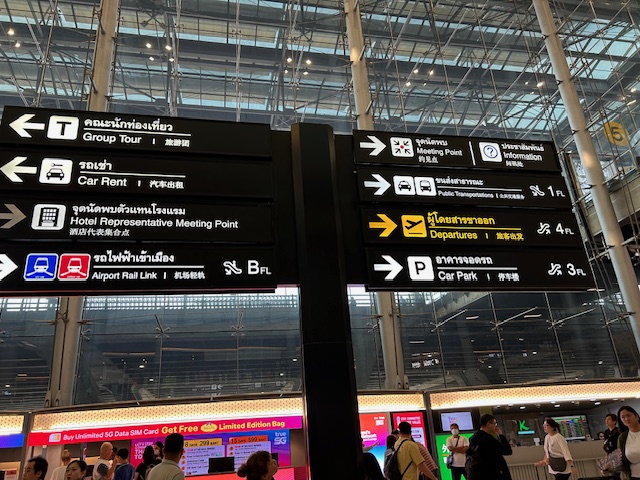 Where to and how to get there? We decided to take the airport taxi to our hotel.
Where to and how to get there? We decided to take the airport taxi to our hotel.
 Marveling at the spacious terminal.
Marveling at the spacious terminal.
I will post about Bangkok and transport in Thailand in the next posts probably after we return from this trip.
–
Taxi services at NAIA Terminal 2
The previous post on NAIA Terminal 2 featured photos of taxi or ride share services at the airport. Coupon Taxis are the most expensive option for travelers as they have the highest rates. Often, these are even higher than vehicle rental rates. These rates are shown to prospective customers though so I can’t really understand why people go for this option and then slam it for being expensive. The information is provided there so accepting the terms means you understand and accept the rates. Perhaps they didn’t have other options?

There is a Grab stand at the terminal. I assume that since Grab is quite popular at least in Southeast Asia (even taking over Uber’s share), then travelers who likely have smart phones should have the app and be able to book a ride using it. This might be the best option for those on the go.

There is also a regular taxi stand at the airport terminal so that is another option. Unfortunately, one will likely have to haggle with the drivers for the fare. Other drivers might use their meters but will suggest or solicit tips from their passengers.
There is no rail service for the NAIA Terminals but there is an airport bus, UBE Express, that travelers can take to go to major CBDs like Cubao, Ortigas and Manila or perhaps to major terminals like PITX or the Victory Liner Terminal in Pasay City.
–
What’s new at NAIA Terminal 2
NAIA’s Terminal 2 now only serves domestic flights. It currently hosts Philippine Airlines and Air Asia flights to major cities. I haven’t been to the parking area or had the opportunity to go around the terminal’s arrival area for some time now. I used to go to NAIA frequently the time when my wife was a frequent international traveler with her former office. If she had trips to the US West Coast (e.g., Los Angeles or San Francisco) she would likely take the direct flights via Philippine Airlines.
 Minute Burger at the kiosk near what was the international (North) wing of NAIA Terminal 2
Minute Burger at the kiosk near what was the international (North) wing of NAIA Terminal 2
 What used to be a Figaro branch at one end of the terminal is now Seattle’s Best Coffee
What used to be a Figaro branch at one end of the terminal is now Seattle’s Best Coffee
 The arrival level driveway at the terminal
The arrival level driveway at the terminal
 Coupon taxi stand at the terminal
Coupon taxi stand at the terminal
 Grab station at the NAIA Terminal 2 arrival level driveway
Grab station at the NAIA Terminal 2 arrival level driveway
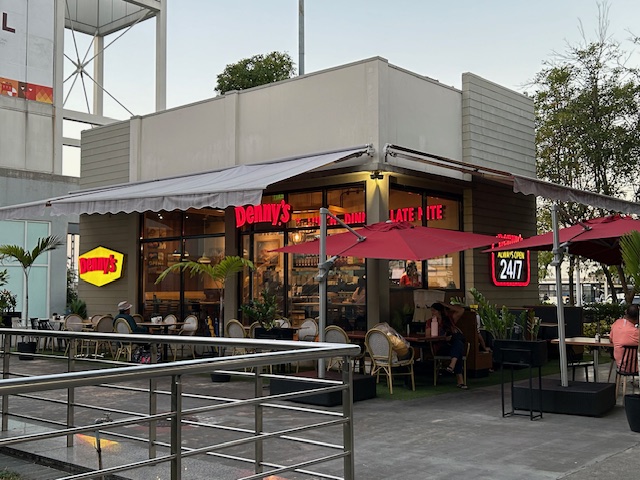 There is a Denny’s at the other end of the terminal. There used to be no restaurant or cafe at what was the domestic (South) wing of the terminal.
There is a Denny’s at the other end of the terminal. There used to be no restaurant or cafe at what was the domestic (South) wing of the terminal.
As I’ve mentioned earlier, I haven’t been able to go around the NAIA terminals aside from the usual departure and arrival areas when I’m traveling. So this one Sunday that I picked up my father as he returned from Iloilo, I took advantage and took photos to share here.
–
What’s new at Zamboanga Airport?
We were back in Zamboanga last week to do some follow-up work on a project on road safety. We also paid a courtesy call to the new City Administrator to reiterate our commitment on helping the city address concerns about child road traffic injury prevention. Of course, I was able to take some new photos of places and food. Among the typical photos I take is of the airport.
 Passengers arriving at the Zamboanga Airport
Passengers arriving at the Zamboanga Airport
 We were greeted by what looked like a new baggage carousel at airport
We were greeted by what looked like a new baggage carousel at airport
 This actually looks like the old one transferred to this position. The new one is currently being set up where the old one was and will probably be operational very soon. That means the airport will be able to separately handle baggage from two arriving planes.
This actually looks like the old one transferred to this position. The new one is currently being set up where the old one was and will probably be operational very soon. That means the airport will be able to separately handle baggage from two arriving planes.
 Colorful vintas on display at the arrival area just next to the baggage claim area
Colorful vintas on display at the arrival area just next to the baggage claim area
–
Back in Davao after 4 years
We conclude the month of November 2023 with a post on a recent travel, which allowed me to take new photos of an airport I’ve frequently used in the past. I was in Davao last week for a national convention. The last time I was there was in August 2019 and before the pandemic so it was a welcome trip for me. Back then and probably even now, Davao was riding high after 3 years of Digong as President. I am glad that Davao is still rapidly progressing. It has so much potential with or without a certain holding key posts in government.

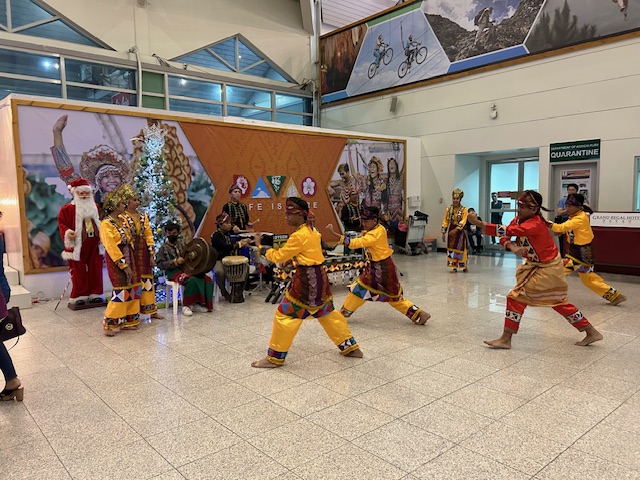
I will be posting about the Francisco Bangoy Airport in the next days. There have been some improvements to the terminal but most remain the same as it was in 2019.
–
First impressions of a country or city – Kuala Lumpur
I recently traveled to Malaysia and just making this quick post of first impressions based on one of its gateways – Kuala Lumpur International Airport. This was not my first trip to Malaysia as I traveled there before but by land and from Singapore (we were residing in Singapore). That time, I traveled to Melaka. Here are photos when we arrived in KLIA last weekend.
 |
| A view of KLIA Terminal 2 as our plane approached to land |
 |
| Two towers – air traffic control towers, that is. The closer one is Terminal 2’s while the one at the distance is Terminal 1. |
 |
| A view of Terminal 2 as our plane taxied to the terminal |
 |
| Terminal 2 is designated for low cost carriers, and is the hub of AirAsia. This terminal replaced the low cost carrier terminal at KLIA, similar to what also happened in Changi. |
 |
| Our plane berthed at the satellite building. This meant we had to walk to the bridge to cross to the main Terminal 2 building. The two buildings are not served by a transit system like KLIA Terminal 1 (or HKIA or Changi, for example). |
 |
| The view of our plane as we crossed on the bridge to the main terminal building. |
 |
| AirAsia planes lined up along one of wings of the satellite building. Each wing is essentially a long pier. |
I was impressed by how large and spacious Terminal 2 is. It is designed, after all, to serve the millions of travelers going through this gateway in what is Southeast Asia’s most visited country for tourists. I just thought though that the moving walkways seemed to be an afterthought and that it was a long walk (healthy though) for many people between the main and satellite buildings. Terminal 2 though is located far from Terminal 1 so transport is required in case you need to transfer from one terminal to the other. It is not as seamless as Changi, for example. Still KLIA is much better than many capital city airports that I’ve been to though there is room for improvements.
–
Another look at the Mactan Cebu International Airport Terminal 1 – Part 3
This is the conclusion to the series on MCIA Terminal 1. Here I am sharing more photos of the shops and also include photos of what used to be the old terminal 1 boarding gates areas that have now been completely renovated.
 Electronics shop at the MCIA Terminal 1
Electronics shop at the MCIA Terminal 1
 There’s a sports bar at Terminal 1
There’s a sports bar at Terminal 1
 There’s a Kultura shop at the Terminal 1. Kultura is SM’s
There’s a Kultura shop at the Terminal 1. Kultura is SM’s
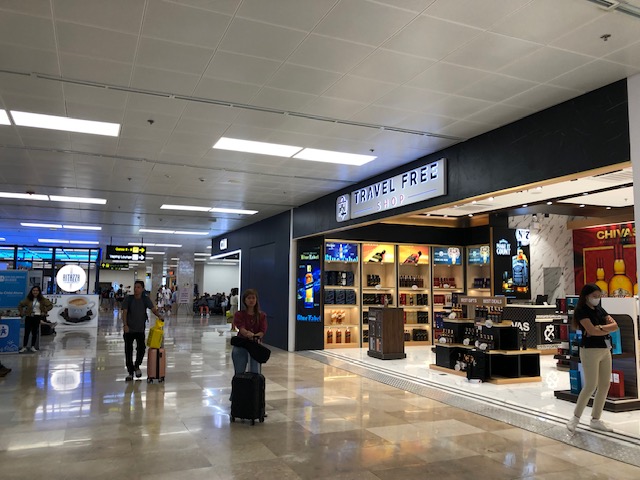 Liquors and wines store at the terminal – I was not able to inquire if these can be duty free considering the people including foreign tourists who may avail of this.
Liquors and wines store at the terminal – I was not able to inquire if these can be duty free considering the people including foreign tourists who may avail of this.
 Passengers seated along a row of restaurants at the old Terminal 1 domestic wing. This area used to be crowded with so many chairs that they tried to fit in the area.
Passengers seated along a row of restaurants at the old Terminal 1 domestic wing. This area used to be crowded with so many chairs that they tried to fit in the area.
 Familiar brands Dunkin’ Donuts and Bo’s Coffee are there. There are also vending machines for drinks for the more straightforward purchases.
Familiar brands Dunkin’ Donuts and Bo’s Coffee are there. There are also vending machines for drinks for the more straightforward purchases.
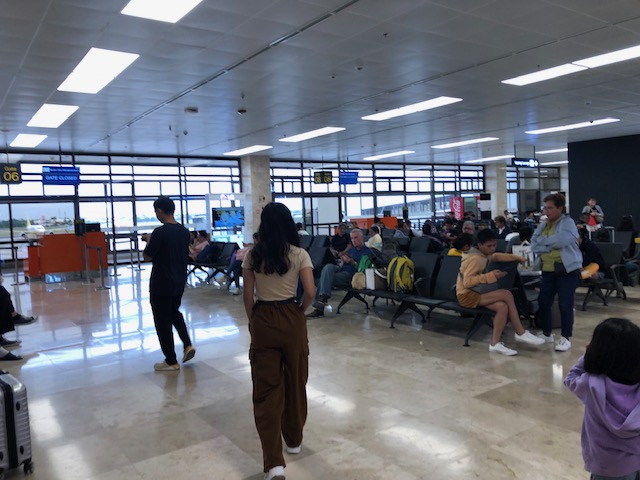 The pre-departure area of the old T1 domestic wing now appears more spacious.
The pre-departure area of the old T1 domestic wing now appears more spacious.
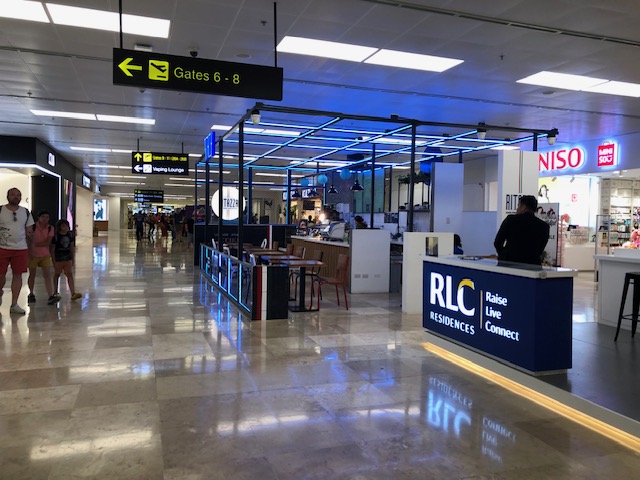 Corridor to the old T1 domestic wing now full of shops
Corridor to the old T1 domestic wing now full of shops
More on airports soon!
–
Another look at the refurbished Mactan International Airport Terminal 1 – Part 2
In this part of the series, I am sharing photos of the various shops and eating options at the MCIA Terminal 1.
 A familiar store at airports is Islands Souvenirs. I think I have an Island Souvenir shirt for most of the cities I’ve traveled to in the country. It is a go-to store for souvenir items, especially shirts.
A familiar store at airports is Islands Souvenirs. I think I have an Island Souvenir shirt for most of the cities I’ve traveled to in the country. It is a go-to store for souvenir items, especially shirts.
 There are many kiosks along the corridors leading to the gates. Some sell souvenir items. Others gadgets and accessories. There are even a couple marketing real estate in Cebu.
There are many kiosks along the corridors leading to the gates. Some sell souvenir items. Others gadgets and accessories. There are even a couple marketing real estate in Cebu.
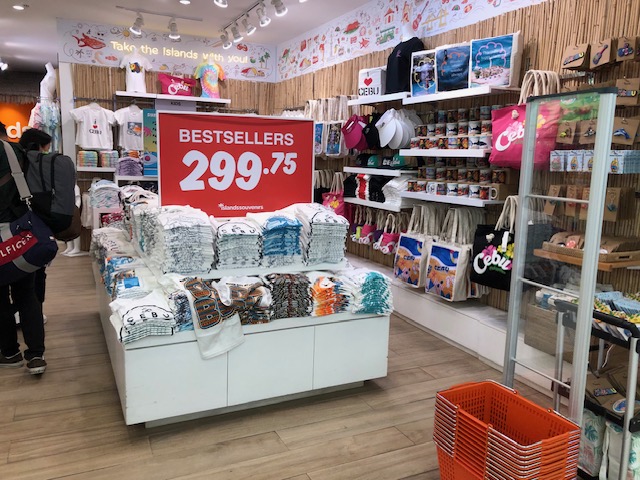 A look inside the Islands Souvenirs shop shows many items to choose from including shirts, bags, caps, mugs and magnets.
A look inside the Islands Souvenirs shop shows many items to choose from including shirts, bags, caps, mugs and magnets.
 I think this store was what used to be a Cocoa Tree store at the terminal. It still sells pretty much the same products (mainly chocolates).
I think this store was what used to be a Cocoa Tree store at the terminal. It still sells pretty much the same products (mainly chocolates).
 There is a nice food court at Terminal 1. You have many choices for eating or drinking. And I noticed the prices are also not as expensive as perceived of Philippine airport food and drinks.
There is a nice food court at Terminal 1. You have many choices for eating or drinking. And I noticed the prices are also not as expensive as perceived of Philippine airport food and drinks.
 The food court is spacious and people can just stay here for refreshments while waiting for their flights to board.
The food court is spacious and people can just stay here for refreshments while waiting for their flights to board.
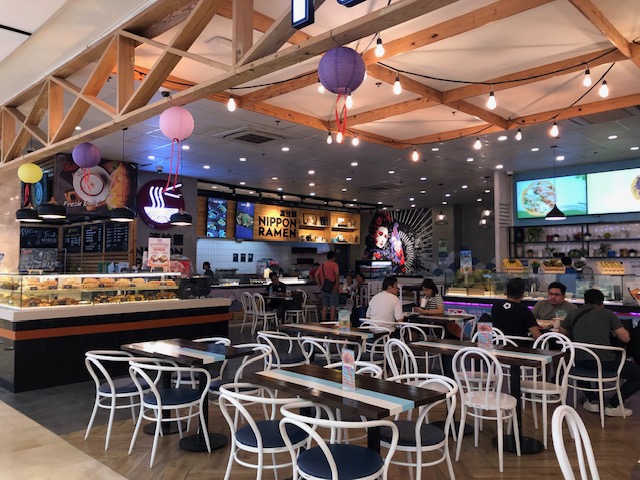 Aside from Filipino food, there’s Italian and Japanese themed stalls at the food court.
Aside from Filipino food, there’s Italian and Japanese themed stalls at the food court.
 I think my favorite there is The Bakery, which offers sandwiches, pastries and various breads. They also have pasta for those wanting a heavier meal before their flights.
I think my favorite there is The Bakery, which offers sandwiches, pastries and various breads. They also have pasta for those wanting a heavier meal before their flights.
 There’s a WHSmith store at Terminal 1. The photo also shows massage chairs and a local souvenir shop, District Fiesta.
There’s a WHSmith store at Terminal 1. The photo also shows massage chairs and a local souvenir shop, District Fiesta.
 District Fiesta offers local products including handicrafts like bags, purses, decors, etc.
District Fiesta offers local products including handicrafts like bags, purses, decors, etc.
More in Part 3, coming soon!
–
Another look at the refurbished Mactan Cebu International Airport Terminal 1 – Part 1
We were recently in Cebu City and I just had to take some new photos; this time to feature Terminal 1 of Mactan Cebu International Airport. Here are some photos taken at the departure area.
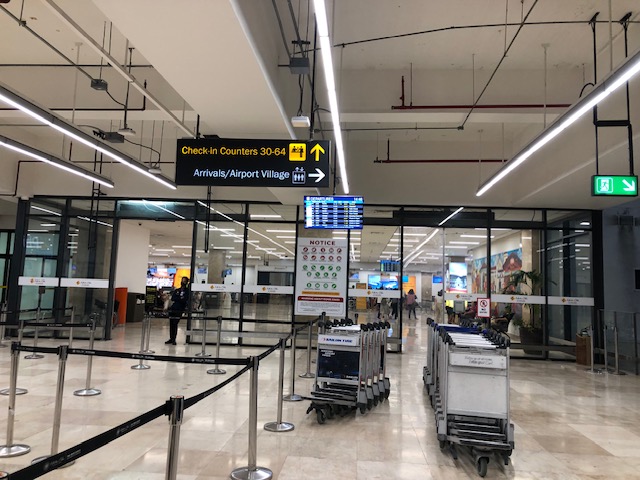 Entrance towards the check-in counters. There is no security machine here and but there is a routine check of travel documents of passengers. There are weighing scales for luggage so passengers can check if they are over their limits and still have an opportunity (and the space) to reconfigure.
Entrance towards the check-in counters. There is no security machine here and but there is a routine check of travel documents of passengers. There are weighing scales for luggage so passengers can check if they are over their limits and still have an opportunity (and the space) to reconfigure.
 PAL’s check-in counters at MCIA Terminal 1
PAL’s check-in counters at MCIA Terminal 1
 PAL also now has online check-in machines at the airport. Previously, only Cebu Pacific had these machines. There is only one though unlike Ceb Pac’s multiple machines.
PAL also now has online check-in machines at the airport. Previously, only Cebu Pacific had these machines. There is only one though unlike Ceb Pac’s multiple machines.
 Check-in counters for Air Asia Philippines
Check-in counters for Air Asia Philippines
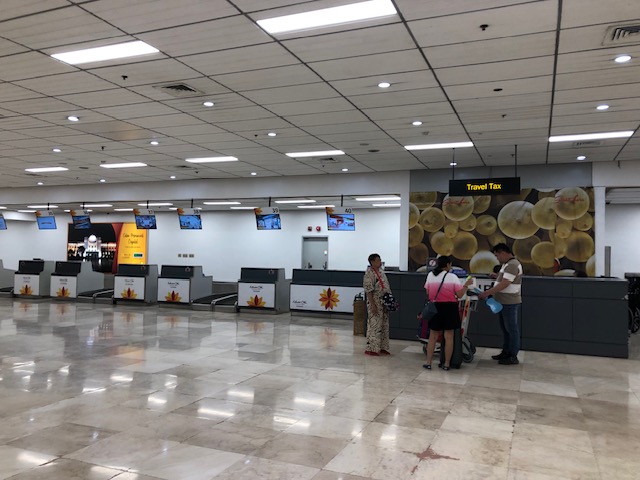 Travel tax counter at the terminal
Travel tax counter at the terminal
 A view of the terminal lobby from the corridor leading to our gate at the other end of Terminal 1.
A view of the terminal lobby from the corridor leading to our gate at the other end of Terminal 1.
 Final security check before the pre-departure areas. MCIA now uses modern scanners for screening both bags and passengers. Shoes and belts are among the items they require you to remove from yourself. They also ask you to remove notebook computers to place them on your tray that goes through the machines. You may not remove your watch from your wrist.
Final security check before the pre-departure areas. MCIA now uses modern scanners for screening both bags and passengers. Shoes and belts are among the items they require you to remove from yourself. They also ask you to remove notebook computers to place them on your tray that goes through the machines. You may not remove your watch from your wrist.
More photos in Part 2 coming soon!
–
Changes in NAIA Terminal 2
We recently traveled via NAIA’s Terminal 2. T2 used to be for Philippine Airlines (PAL) only but recently Air Asia’s domestic flights have been reassigned to use T2 as well. Another airline, Royal Air, also now uses T2 for its domestic flights. Meanwhile, PAL’s international flights now use Terminal 1. Only recently did I notice that PAL now has the north wing of T2 for its domestic flights while Air Asia and Royal Air use the south wing. Previously, PAL’s international flights were on the north wing and domestic flights were at the south wing. Gone are immigration counters though customs equipment and still at the north wing arrival area near the baggage claim carousels.
 The Terminal 2 North Wing was previously for PAL international flights only.
The Terminal 2 North Wing was previously for PAL international flights only.
 The north wing does not serve all of PAL’s domestic flights so it does not appear to be congested. Only flights to the major domestic destinations go through here such as those between Manila and Cebu, Davao, Iloilo, Bacolod or Cagayan De Oro. I seem to have heard a boarding call for PAL’s Caticlan bound flights at T2, too.
The north wing does not serve all of PAL’s domestic flights so it does not appear to be congested. Only flights to the major domestic destinations go through here such as those between Manila and Cebu, Davao, Iloilo, Bacolod or Cagayan De Oro. I seem to have heard a boarding call for PAL’s Caticlan bound flights at T2, too.
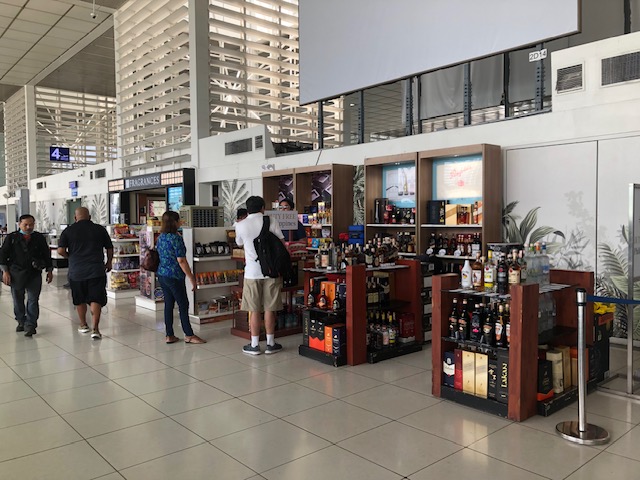 The Duty Free Shops are still here but charge tax for those not qualified for duty free purchases.
The Duty Free Shops are still here but charge tax for those not qualified for duty free purchases.
 There’s a Cafe France at the north wing. There are no other familiar brand cafe choices there.
There’s a Cafe France at the north wing. There are no other familiar brand cafe choices there.
 Antigen self test vending machine at the terminal
Antigen self test vending machine at the terminal
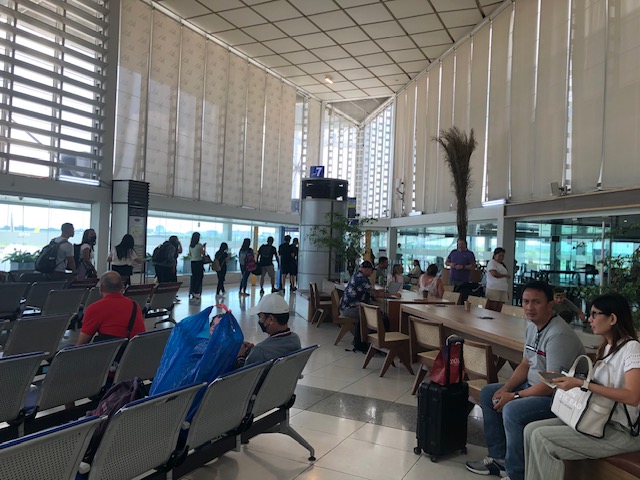 At the south end of the North Wing is the smoking area and a connection to the South Wing pre-departure lounge. There is also a long desk for those who want to work while waiting for their flights.
At the south end of the North Wing is the smoking area and a connection to the South Wing pre-departure lounge. There is also a long desk for those who want to work while waiting for their flights.
I was not able to go to the South Wing and it would be interesting to see what is there and how the area is laid out (is there something different now that Air Asia and Royal Air uses the terminal?) I hope to get that chance soon so I can also take some photos that I can share here.
–
